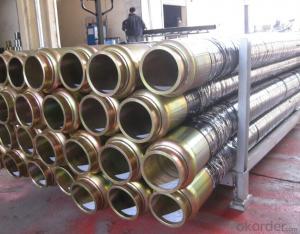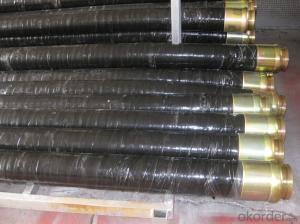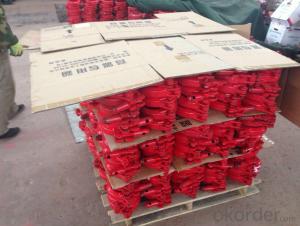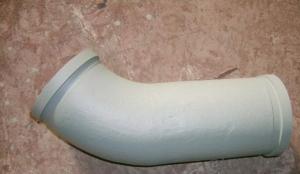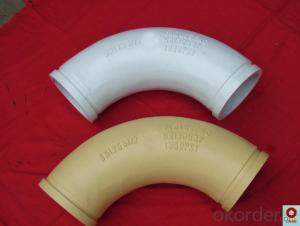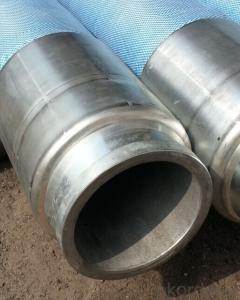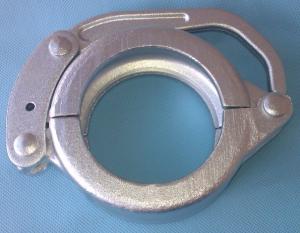4M*DN150RUBBER END HOSE WITH ONE SIDE COUPLINGS WORKING PRESSURE 85 BAR
- Loading Port:
- Shanghai
- Payment Terms:
- TT OR LC
- Min Order Qty:
- 10 pc
- Supply Capability:
- 5000 pc/month
OKorder Service Pledge
OKorder Financial Service
You Might Also Like
Specifications
Putzmeister concrete pump end rubber hose
1. Size: DN150, DN125, DN100, DN80...
2. Length: 1~9m
Concrete pump end rubber hose PM &Schwing
Name | Specifications | Application | Flange diameter | Remarks |
Rubber hose | DN125*3000 | Concrete pump | 148/DN157mm | |
Rubber hose | DN150*3000 | Concrete pump | 148/DN157mm | |
High pressure | DN125*3000 | Concrete pump | 148/DN157mm | Two layers of steel wire |
High pressure | DN125*3000 | Concrete pump | 148/DN157mm | Four layers of steel wire |
High pressure | DN125*4000 | Concrete pump | 148/DN157mm | |
High pressure | DN150*3000 | Concrete pump | 175mm | |
| DN80*5000 | Mortar pump mini conctete pump | 98mm | |
| DN80*6000 | Mortar pump mini conctete pump | 98mm | |
| DN100*5000 | Mortar pump mini conctete pump | 124mm | |
| DN76*6000 | Fine stone concrete pump mini conctete pump |
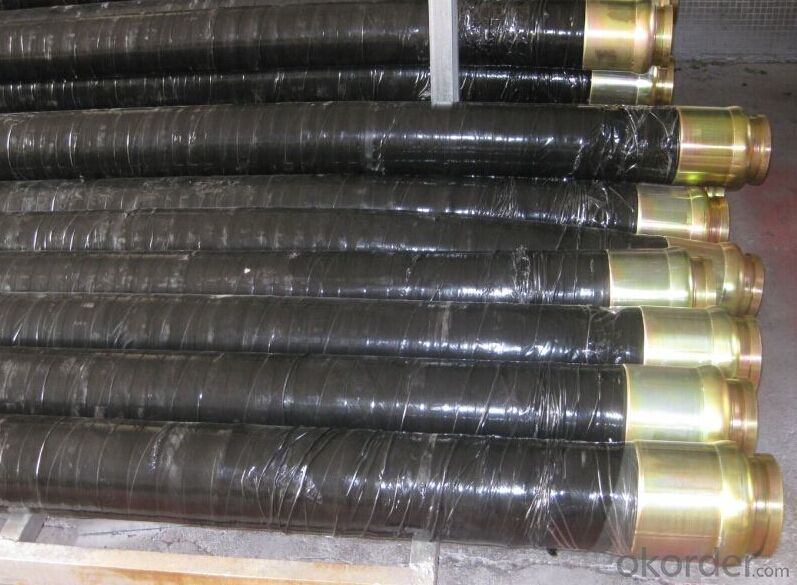
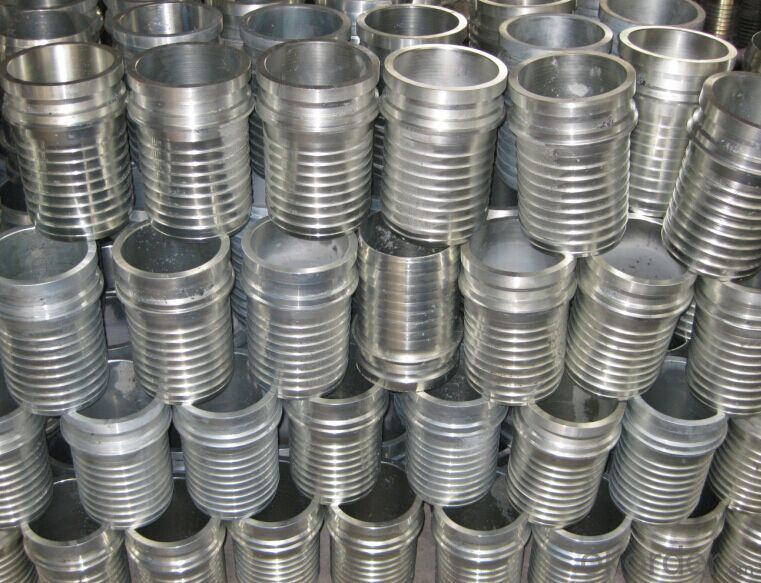
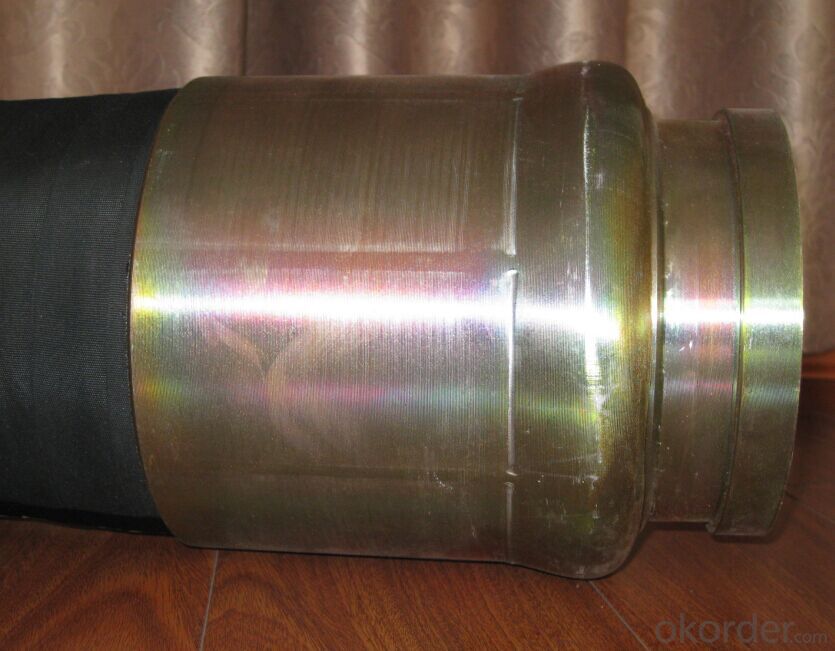

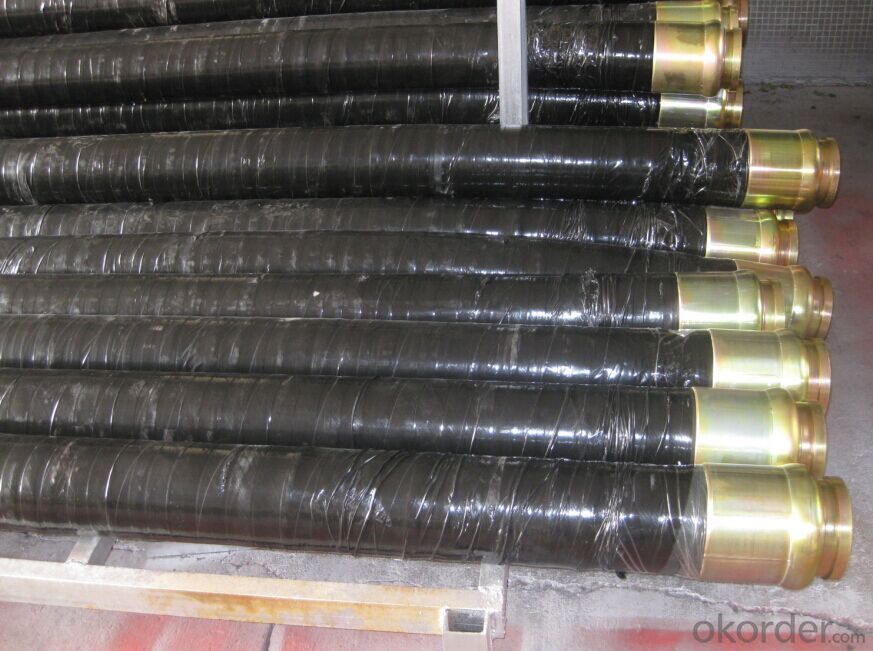
- Q: Can I get spare parts for concrete pump hydraulic cylinders and valves?
- Yes, spare parts for concrete pump hydraulic cylinders and valves are generally available. It is recommended to contact the manufacturer or a reputable supplier to inquire about the specific parts you need for your concrete pump.
- Q: What are the advantages of using carbon fiber components in concrete pump spare parts?
- Using carbon fiber components in concrete pump spare parts offers numerous benefits. To begin with, carbon fiber is renowned for its exceptional strength-to-weight ratio. This means that carbon fiber components can provide the same level of strength as traditional materials like steel or aluminum, but with significantly less weight. Consequently, spare parts made from carbon fiber are lighter, making them easier to handle and install, while also reducing the overall weight of the concrete pump system. Furthermore, carbon fiber exhibits remarkable resistance to corrosion. Unlike steel, carbon fiber does not rust or deteriorate when exposed to moisture or chemicals. This makes it an ideal material for concrete pump spare parts, as they are constantly exposed to water, cement, and other corrosive substances. The corrosion resistance of carbon fiber ensures the long-lasting durability of the spare parts, diminishing the need for frequent replacements and maintenance. Another advantage of carbon fiber components is their high stiffness. Carbon fiber is well-known for its rigidity and minimal flexural deformation, meaning that spare parts crafted from carbon fiber experience minimal deflection when subjected to heavy loads. This stiffness helps maintain the overall stability and performance of the concrete pump system, ensuring accurate and efficient pumping of concrete. In addition, carbon fiber demonstrates excellent fatigue resistance. Since concrete pump spare parts endure continuous cyclic loading and unloading, they are susceptible to fatigue failure over time. However, carbon fiber components possess the ability to withstand these cyclic loads without compromising their structural integrity. This enhances the reliability and lifespan of the spare parts, reducing downtime and maintenance costs. Lastly, carbon fiber offers unparalleled design flexibility. It can be easily molded into intricate shapes and geometries, allowing for the creation of customized spare parts tailored to specific requirements. This design flexibility empowers the optimization of spare parts' performance, enhancing the overall efficiency and productivity of the concrete pump system. In conclusion, utilizing carbon fiber components in concrete pump spare parts presents a multitude of advantages, including their outstanding strength-to-weight ratio, corrosion resistance, stiffness, fatigue resistance, and design flexibility. These qualities contribute to the enhanced performance, durability, and cost-effectiveness of the concrete pump system.
- Q: What is the role of a concrete pump agitator shaft seal?
- The role of a concrete pump agitator shaft seal is to prevent leakage of concrete slurry or other fluids from the agitator shaft, ensuring that the pump operates efficiently and without any loss or contamination of the material being pumped.
- Q: How long does it take to receive concrete pump spare parts after ordering?
- The delivery time for concrete pump spare parts can differ based on various factors. It is crucial to acknowledge that the availability of the specific parts you require and the location of the supplier can have a significant impact on the time it takes for them to arrive. Generally, if the spare parts are readily available and in stock, you can expect to receive them within a few days to a week. This assumes that the supplier has an efficient order processing system and prompt shipping arrangements. However, if the spare parts are not in stock, the duration to receive them may be longer. In such instances, the supplier might need to order the parts from a manufacturer or source them from a distributor. This could result in additional lead time for delivery, ranging from a few weeks to several months, depending on availability and the sourcing process. To obtain an estimate of the delivery time, it is advisable to consult with the supplier or manufacturer before placing your order. Additionally, factors like the supplier's location, transportation mode, and potential customs or logistics delays should be taken into consideration. If you require the spare parts urgently, some suppliers may offer expedited shipping options for an extra cost. This can be advantageous in expediting the delivery process. In conclusion, the time it takes to receive concrete pump spare parts after ordering can vary. However, by being proactive, maintaining communication with the supplier, and planning ahead, you can help ensure a smoother and quicker delivery process.
- Q: What is the purpose of a concrete pump wear plate?
- The purpose of a concrete pump wear plate is to protect the pumping system from wear and tear caused by the abrasive nature of concrete. Concrete pumps are used to transfer concrete from the mixer to the construction site, and during this process, the concrete passes through the wear plate. It acts as a barrier between the pumping system and the abrasive concrete, preventing direct contact and reducing the damage caused by the constant flow of concrete. The wear plate is typically made of durable materials such as hardened steel or tungsten carbide, which are resistant to the abrasive forces exerted by the concrete. By having a wear plate in place, the lifespan of the pumping system is significantly extended, reducing the need for frequent repairs and replacements. Overall, the purpose of a concrete pump wear plate is to ensure the efficient and reliable operation of concrete pumps by protecting and preserving the integrity of the pumping system.
- Q: What are the indications of a weak or dead remote control battery?
- The indications of a weak or dead remote control battery can vary depending on the type of remote control being used. However, some common indications include a noticeable decrease in the range or distance at which the remote control can operate. This means that you may need to be closer to the device you are trying to control in order for the remote to work properly. Another indication is when the remote control buttons become unresponsive or require multiple presses to function. You may also notice a delay in the response time of the device when using the remote control. In some cases, the remote control may stop functioning altogether, indicating that the battery is completely dead. If you experience any of these signs, it is recommended to replace the battery in the remote control to ensure reliable performance.
- Q: Can I get spare parts for concrete pump boom arms and pipes?
- Yes, you can definitely get spare parts for concrete pump boom arms and pipes. There are various suppliers and manufacturers that specialize in providing spare parts for concrete pumps. These spare parts include boom arms, pipes, couplings, gaskets, seals, and other components that are necessary for the proper functioning of a concrete pump. You can search for these spare parts online, where you will find numerous websites and online stores that offer a wide range of options. It is important to ensure that you purchase spare parts from reputable suppliers to ensure their quality and compatibility with your specific concrete pump model. Additionally, there are also local dealers and distributors who stock spare parts for concrete pumps. You can inquire with them or visit their stores to find the required spare parts for your boom arms and pipes. Regular maintenance and replacement of worn-out or damaged parts is crucial for the efficient and safe operation of a concrete pump. By investing in high-quality spare parts, you can extend the lifespan of your equipment and ensure its optimal performance.
- Q: How can one ensure proper alignment and positioning of concrete pump spare parts during installation?
- Achieving the desired alignment and positioning of concrete pump spare parts during installation is crucial for the pump's efficient and safe operation. Here are some important steps to follow: 1. Familiarize yourself with the manufacturer's instructions: Before starting the installation process, carefully read and understand the instructions and guidelines provided by the manufacturer. These instructions will give you specific information on how to align and position the spare parts for your concrete pump model. 2. Prepare the work area properly: Clear any debris, dust, or obstacles from the work area that could hinder the installation process. A clean and organized work environment will make it easier to accurately position and align the spare parts. 3. Use appropriate lifting equipment: Concrete pump spare parts can be heavy and require special lifting equipment to prevent damage or injuries. Utilize cranes, hoists, or forklifts to lift and position the spare parts accurately and safely. 4. Employ precise measuring tools: Invest in high-quality measuring tools like laser levels, alignment guides, and precision measuring tapes. These tools will help you ensure precise alignment and positioning of the spare parts during installation. 5. Verify dimensions and specifications: Before installing any spare part, compare the dimensions and specifications provided by the manufacturer with the actual part. This will help you identify any discrepancies or potential issues that need to be addressed before installation. 6. Follow a systematic installation process: Begin with the main components of the concrete pump and gradually proceed to the spare parts. Follow a step-by-step approach, meticulously aligning and positioning each spare part according to the manufacturer's instructions. 7. Seek professional assistance if necessary: If you are uncertain about the proper alignment and positioning of certain spare parts, don't hesitate to seek professional assistance. Consulting experienced technicians or contacting the manufacturer's customer support can provide valuable guidance and ensure correct installation. 8. Perform a final inspection: Once all the spare parts are installed, conduct a thorough inspection to verify the alignment and positioning. Check for any visible gaps, misalignments, or irregularities. Immediately address any issues to ensure the proper function and longevity of the concrete pump. By following these steps and paying attention to detail, you can guarantee the proper alignment and positioning of concrete pump spare parts during installation, resulting in a dependable and efficient pump system.
- Q: What are the key considerations when purchasing spare parts for a concrete pump?
- When purchasing spare parts for a concrete pump, the key considerations include ensuring compatibility with the specific make and model of the pump, quality and durability of the parts, availability and delivery time, cost-effectiveness, and the reputation and reliability of the supplier.
- Q: How can a faulty lubrication system affect the pump's performance?
- A faulty lubrication system can significantly affect the pump's performance in several ways. Firstly, a lubrication system is responsible for providing a thin film of lubricant between moving parts of the pump, reducing friction and wear. If the lubrication system is faulty or inadequate, it can result in increased friction between components, leading to excessive heat generation and accelerated wear and tear. This can ultimately reduce the efficiency and lifespan of the pump. Secondly, a faulty lubrication system can cause inadequate lubrication to critical components, such as bearings and seals. Insufficient lubrication can lead to increased friction, heat, and ultimately, premature failure of these components. This can result in increased downtime, costly repairs, and potential damage to other parts of the pump. Furthermore, a faulty lubrication system can also result in the contamination of the lubricant. Contaminants such as dirt, debris, or moisture can enter the system due to leaks or improper maintenance. These contaminants can cause abrasive damage to the pump's internal components, leading to reduced efficiency, increased wear, and potential failure. Lastly, a faulty lubrication system can also impact the pump's overall performance and energy consumption. Insufficient lubrication can increase the power requirements of the pump as it works harder to overcome friction and resistance. This can result in higher energy consumption and increased operating costs. In conclusion, a faulty lubrication system can severely impact the pump's performance by causing increased friction, accelerated wear and tear, premature failure of critical components, contamination of the lubricant, and increased energy consumption. Regular maintenance and proper lubrication are crucial to ensure the pump operates at its optimal level and to extend its lifespan.
Send your message to us
4M*DN150RUBBER END HOSE WITH ONE SIDE COUPLINGS WORKING PRESSURE 85 BAR
- Loading Port:
- Shanghai
- Payment Terms:
- TT OR LC
- Min Order Qty:
- 10 pc
- Supply Capability:
- 5000 pc/month
OKorder Service Pledge
OKorder Financial Service
Similar products
Hot products
Hot Searches
Related keywords
